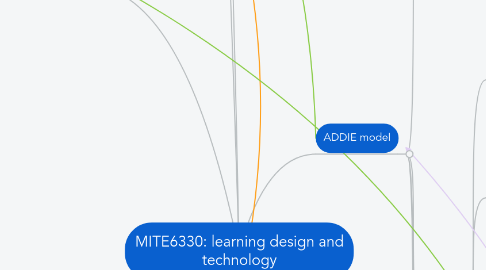
1. learning theories
1.1. key theories
1.1.1. behaviorism:stimulas and response
1.1.1.1. student learn from
1.1.1.1.1. practice
1.1.1.1.2. re-shaping what is learnt
1.1.1.1.3. positive experiences
1.1.1.2. teachers' role
1.1.1.2.1. series of steps in programmed instruction
1.1.1.2.2. pre-defined end
1.1.1.2.3. supervisor role
1.1.1.3. goal:
1.1.1.3.1. learning is observed by a change in behavior
1.1.1.3.2. learning attributed internally
1.1.2. cognitivism
1.1.2.1. student learn from
1.1.2.1.1. mental processing
1.1.2.1.2. acquiring strategies
1.1.2.2. teachers' role
1.1.2.2.1. attain and maintain learners' attention
1.1.2.2.2. moderate strategies
1.1.2.3. goal
1.1.2.3.1. change students' mental behavior
1.1.3. constructivism
1.1.3.1. student learn from
1.1.3.1.1. construction of knowledge
1.1.3.1.2. socialising
1.1.3.1.3. self lead
1.1.3.2. teachers' role
1.1.3.2.1. pose leading questions
1.1.3.2.2. group students to learn with and through each other
1.1.3.2.3. facilitator
1.1.3.3. goal
1.1.3.3.1. life long sticky learning
1.1.4. connectivism
1.1.4.1. student learn through
1.1.4.1.1. informal, network,technology enabled environment
1.1.4.1.2. connecting information
1.1.4.1.3. desire to know more
1.1.4.1.4. decision making
1.1.4.2. teachers' role
1.1.4.2.1. nature connections
1.1.4.3. goal
1.1.4.3.1. student ability to do something
1.1.4.3.2. learning and actuation
2. instructional design
2.1. definition: ID is the creation of instructional experiences which makes the acquisition of knowledge and skill more effective, efficient and appealing. (Merrill,Drake,Lacy,Pratt (1996))
2.2. instructional designer
2.2.1. tools ( how to do)
2.2.1.1. process: the instructional designer go through when creating instruction.
2.2.1.1.1. ADDIE model (analyze, design, develop,implement,evaluation)
2.2.1.1.2. Dick and Carey model (systematic design of instruction)
2.2.1.1.3. RASE model (resource analysis support evaluation)
2.2.1.2. theory: offers guidance to learners on how to actually learn.
2.2.1.2.1. what structure look like
2.2.1.2.2. what type of strategy should be used
2.2.1.3. physical: the tool the instructional design use.
2.2.1.3.1. pen/paper
2.2.1.3.2. e-learning study tool
2.2.2. people (whom to do with)
2.2.2.1. management
2.2.2.2. other ID teams
2.2.2.3. SMEs (subject matter experts)
2.2.2.4. learners (target audience)
2.2.3. organizations (where to do)
2.2.3.1. government
2.2.3.2. corporation
2.2.3.3. military
2.2.3.4. higher education
2.2.3.5. K-12
2.3. instructional materials
2.3.1. printed and duplicated materials
2.3.2. non-project display materials
2.3.3. still projected display materials
2.3.4. technological instructional media
2.4. why do we need instructional design?
2.4.1. my underatanding
3. brain science
3.1. forgetting curve
3.1.1. why can't people remember things for long? the forgetting curve is normal
3.1.2. how to cope with the forgetting curve: lose it or use it
3.1.3. how to overcome the forgetting curve
3.1.3.1. memory boosters
3.1.3.2. five-second rule
3.1.3.3. with the help of mobile devices
3.2. long-term memory
3.3. short-term memory
4. the relationship between learning and technology
4.1. learning from technology
4.1.1. technology as a teacher: teacher-cented
4.1.2. reusable learning objects
4.1.3. instructivist models
4.1.3.1. drill and practice
4.1.3.2. computer-based tutorials
4.1.3.3. intelligent tutorial system
4.2. learning about technology
4.3. learning with technology
4.3.1. technology as intellectual partner: learner-centerd
4.3.2. interactive learning objects
4.3.3. constructivist model
4.3.3.1. inquiries and problem solving
4.3.3.2. cognitive tools
4.3.3.3. on-line collaboration and knowledge building
5. way forward
5.1. web 2.0
5.1.1. User control of information
5.1.2. New forms of expression
5.1.3. Web as a point of presence
5.1.4. Internet-mediated social/collective activities
5.1.5. Web as a platform
5.1.6. Rich user experiences
5.2. blended learning
5.2.1. a mixture of face to face and online learning
5.3. e-book
6. ADDIE model
6.1. analysis
6.1.1. job situation
6.1.1.1. equipment and material
6.1.1.2. environment condition
6.1.1.3. methods and situation on the job
6.1.1.4. Assistance through job aids, manuals or supervision
6.1.2. job standard
6.1.2.1. standard operating procedures
6.1.2.2. without error
6.1.2.3. time limit
6.1.2.4. rate of production
6.1.3. task analysis
6.1.3.1. learning goals
6.1.3.1.1. very general
6.1.3.2. learning objective
6.1.3.2.1. more specific
6.1.3.3. hierarchical task diagram (based on the assumption that learning is hierarchical)
6.1.3.3.1. job
6.1.3.3.2. tasks
6.1.3.3.3. subtasks
6.1.3.4. working standard
6.1.4. learner analysis
6.1.4.1. Maslow's hierarchy needs
6.1.4.1.1. Physiological needs
6.1.4.1.2. Safety needs
6.1.4.1.3. Love and belonging needs
6.1.4.1.4. Esteem needs
6.1.4.1.5. Self-actualization needs
6.1.4.2. to be specific
6.1.4.2.1. learners are with different characteristics
6.1.4.2.2. learners are different from ourselves
6.1.4.2.3. concentrate both diverisities and similarities
6.1.4.3. adult learner
6.1.4.3.1. difference from child learners
6.1.5. content analysis
6.1.5.1. prior knowledge
6.1.5.2. prerequisite knowledge
6.1.6. Contextual analysis
6.1.7. Delivery analysis
6.2. design
6.2.1. design assessments
6.2.1.1. analysis
6.2.1.1.1. goals, learners,context,assessments
6.2.1.2. learning objective
6.2.1.2.1. ABCD of writing objectives
6.2.1.2.2. Bloom's taxonomy
6.2.2. choose a course format
6.2.2.1. how to apply
6.2.2.1.1. online
6.2.2.1.2. face-to-face
6.2.2.2. the medium going to use
6.2.3. create an instructional strategy
6.2.3.1. Gange's nine events of instruction
6.2.3.1.1. Gaining attention
6.2.3.1.2. Informing learner of lesson objective
6.2.3.1.3. Stimulating recall of prior learning
6.2.3.1.4. Presenting stimuli
6.2.3.1.5. Guiding learning
6.2.3.1.6. Eliciting performance
6.2.3.1.7. Providing informative feedback
6.2.3.1.8. Assessing performance
6.2.3.1.9. Enhancing retention and learning transfer
6.2.3.2. 7 principles of good practices
6.2.3.2.1. encourages Student-Faculty Contact
6.2.3.2.2. encourage Cooperation among Students
6.2.3.2.3. Encourages Active Learning
6.2.3.2.4. Gives Prompt Feedback
6.2.3.2.5. Emphasizes Time on Task
6.2.3.2.6. Communicates High Expectations
6.2.3.2.7. Respects Diverse Talents and Ways of Learning
6.2.3.3. 5 first principles of effective instruction
6.2.3.3.1. activation: Learning is promoted when existing knowledge is activated as a foundation for new knowledge
6.2.3.3.2. demonstration: Learning is promoted when new knowledge is demonstrated to the learner
6.2.3.3.3. application: Learning is promoted when knowledge is applied by the learner
6.2.3.3.4. integration:Learning is promoted when new knowledge is integrated into the learner’s world
6.2.3.3.5. problem solving:Learning is promoted when learners are engaged in solving problems
6.3. develop
6.3.1. create a sample
6.3.1.1. Gantt chart management: the timeline of the design work
6.3.1.2. flow chart: the framework of the design work
6.3.2. develop the course materials
6.3.2.1. storyboard
6.3.3. conduct a run-through
6.3.3.1. prototype
6.4. implenment
6.4.1. train the instructor
6.4.2. prepare the learner
6.4.3. arrange the learning space
6.5. evaluation
6.5.1. Level 1 – Reaction
6.5.1.1. customer satisfaction
6.5.1.1.1. methods of evaluation: surveys
6.5.2. Level 2--Learning
6.5.2.1. Knowledge, Skills
6.5.2.1.1. methods of evaluation: test, essay,paper,project,presentation
6.5.2.2. forgetting curve
6.5.3. Level 3--Behavior
6.5.3.1. Transfer of learning to the real-world
6.5.3.1.1. methods of evaluation
6.5.4. Level 4 – Results
6.5.4.1. Bottom line:something more about efficiency, measurement,

